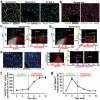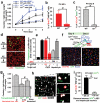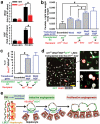Inductive angiocrine signals from sinusoidal endothelium are required for liver regeneration
- PMID: 21068842
- PMCID: PMC3058628
- DOI: 10.1038/nature09493
Inductive angiocrine signals from sinusoidal endothelium are required for liver regeneration
Abstract
During embryogenesis, endothelial cells induce organogenesis before the development of circulation. These findings suggest that endothelial cells not only form passive conduits to deliver nutrients and oxygen, but also establish an instructive vascular niche, which through elaboration of paracrine trophogens stimulates organ regeneration, in a manner similar to endothelial-cell-derived angiocrine factors that support haematopoiesis. However, the precise mechanism by which tissue-specific subsets of endothelial cells promote organogenesis in adults is unknown. Here we demonstrate that liver sinusoidal endothelial cells (LSECs) constitute a unique population of phenotypically and functionally defined VEGFR3(+)CD34(-)VEGFR2(+)VE-cadherin(+)FactorVIII(+)CD45(-) endothelial cells, which through the release of angiocrine trophogens initiate and sustain liver regeneration induced by 70% partial hepatectomy. After partial hepatectomy, residual liver vasculature remains intact without experiencing hypoxia or structural damage, which allows study of physiological liver regeneration. Using this model, we show that inducible genetic ablation of vascular endothelial growth factor (VEGF)-A receptor-2 (VEGFR2) in the LSECs impairs the initial burst of hepatocyte proliferation (days 1-3 after partial hepatectomy) and subsequent reconstitution of the hepatovascular mass (days 4-8 after partial hepatectomy) by inhibiting upregulation of the endothelial-cell-specific transcription factor Id1. Accordingly, Id1-deficient mice also manifest defects throughout liver regeneration, owing to diminished expression of LSEC-derived angiocrine factors, including hepatocyte growth factor (HGF) and Wnt2. Notably, in in vitro co-cultures, VEGFR2-Id1 activation in LSECs stimulates hepatocyte proliferation. Indeed, intrasplenic transplantation of Id1(+/+) or Id1(-/-) LSECs transduced with Wnt2 and HGF (Id1(-/-)Wnt2(+)HGF(+) LSECs) re-establishes an inductive vascular niche in the liver sinusoids of the Id1(-/-) mice, initiating and restoring hepatovascular regeneration. Therefore, in the early phases of physiological liver regeneration, VEGFR2-Id1-mediated inductive angiogenesis in LSECs through release of angiocrine factors Wnt2 and HGF provokes hepatic proliferation. Subsequently, VEGFR2-Id1-dependent proliferative angiogenesis reconstitutes liver mass. Therapeutic co-transplantation of inductive VEGFR2(+)Id1(+)Wnt2(+)HGF(+) LSECs with hepatocytes provides an effective strategy to achieve durable liver regeneration.
Figures




Comment in
-
Key role of sinusoidal endothelial cells in the triggering of liver regeneration.J Hepatol. 2011 Aug;55(2):488-90. doi: 10.1016/j.jhep.2011.02.005. Epub 2011 Feb 22. J Hepatol. 2011. PMID: 21349303 No abstract available.
-
Sinusoidal endothelium is essential for liver regeneration.Hepatology. 2011 Aug;54(2):731-3. doi: 10.1002/hep.24455. Hepatology. 2011. PMID: 21793020 No abstract available.
References
-
- Matsumoto K, Yoshitomi H, Rossant J, Zaret KS. Liver organogenesis promoted by endothelial cells prior to vascular function. Science. 2001;294:559–563. - PubMed
-
- Lammert E, Cleaver O, Melton D. Induction of pancreatic differentiation by signals from blood vessels. Science. 2001;294:564–567. - PubMed
-
- Butler JN, Vertes J, Varnum-Finney E, Kobayashi B, Hooper H, Seandel A, Shido M, White K, Kobayashi I, Witte M, May L, Shawber C, Kimura C, Kitajewski Y, Rosenwaks J, Bernstein Z, Rafii I, Endothelial S. Cells Are Essential for the Self-Renewal and Repopulation of Notch-Dependent Hematopoietic Stem Cells. Cell Stem Cell. 2010;6:1–14. - PMC - PubMed
Publication types
MeSH terms
Substances
Associated data
- Actions
Grants and funding
LinkOut - more resources
Full Text Sources
Other Literature Sources
Medical
Molecular Biology Databases
Research Materials
Miscellaneous

